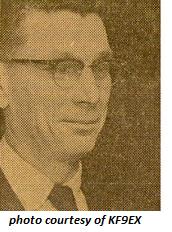 |
W9CWG Donald E. 'Gene' Wiggins Valparaiso, IN QCWA #6040 Chapter36 |
REVISED BY GENE - 4/12/2009
From: Gene Wiggins, W9CWG, in a letter dated 6 April 2009
Re: Valpo Tech, W9SAL and Bill Harris, and QCWA
About W9SAL. I really know very little of the early history on this call. The school, then known as Dodge Telegraph and Radio Institute, closed for one year during the Depression that started in 1929, reopened in 1934. In that era All States Radio Club was formed. And I have always assumed the call W9SAL was issued to them. I came on the scene first in 1942 and that call was there, although hams were off the air at that time due to WW2. I was associated with the school in 1942 to March 1943. Then in 1946-47, then back as a faculty in 1953. I assumed Trustee (or Trusty) in the early 1950's as the ticket came up for renewal. The license normally ran concurrent with my W9CWG license. I kept W9SAL until my license came up for renewal in 2005, then decided to let W9SAL go. We had no school, had no club, no nothing, so I put it up for reissue.
I left Tech in 1947 and was chief of an AM broadcast station in my hometown in Ohio. It was a newspaper owned station. Three brothers inherited the newspaper and added the broadcast facility in 1947. On a vacation trip back to Valpo (my wife is a native), Doc Hershman got hold of me and advised he had an opening on the staff and offered the position. I basically took the position held by Jim Drake, then W9ZUG, now W5EF if not SK (have not contacted him for ages). Jim left Tech to join Sandia Corp. in Albuquerque. Also, a Bill Harris that was on staff, W8WWK, was in the Valpo Hospital. When I finally got moved to Valpo in September, Bill Harris had already died and his mother in Ashtabula, OH donated his Collins 32V2 transmitter and 75A1 receiver to W9SAL. (That's Ash ta beula, not Ash tab u la!) So we made W9SAL the Bill Harris Memorial Station. Bill had either attended, or was a grad of Muskingum College in New Concord, OH, 25 miles from my home. I never really knew what he taught at Tech or for how long. It was not very long.
My history for QCWA. I was ready to take the ham test prior to WW2, but no way to get to Detroit. They came to Columbus and Cleveland quarterly but I never made it. Finally took the test in 1943 in Chicago, operator license only, no station license or call. Back home in 1946 and got W8YEG. Then got the W9CWG in 1954 here in Valpo. I applied for QCWA in 1958, 25 years after the 1943 issue. No proof in a callbook obviously, and had lost that original license. Gus Gironda, W2JE, was sec'y and during this discussion he mentioned he was being installed as Master of a Masonic Lodge in his hometown. Being a Past Master, I called Gus on the telephone the evening he was being installed and passed on my congratulations. Just to add a little personal touch to my early QCWA!
In a letter from Gene Wiggins, W9CWG, dated 19 April 2009
Following is a random history of my personal connection with Valpo Tech, ham radio, Herb Brier, and other material.
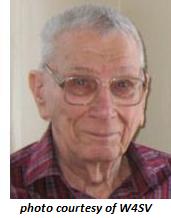 I came to Valpo to attend Dodge Telegraph and Radio Institute in 1942. Attendance was small due to the fact that WW2 was in full swing. Within a very short time I was told about Herb Brier in Gary. I was not a licensed ham at this point. March 1943 just about wiped out the student body at Dodge, we all ended up in the military.
I came to Valpo to attend Dodge Telegraph and Radio Institute in 1942. Attendance was small due to the fact that WW2 was in full swing. Within a very short time I was told about Herb Brier in Gary. I was not a licensed ham at this point. March 1943 just about wiped out the student body at Dodge, we all ended up in the military.
Personally, I was in various assignments and ended up in the South Pacific on the island of Luzon. Bombs dropped, our disagreement with the Japanese ended, we loaded on LST's on the southern tip of Luzon and were the first troops to occupy Honshu.
A former student at Valpo Tech is Marvin Beach, N4NY, in South Carolina, retired college teacher. He married a girl from Batangas, near where we loaded onto the LST's. She recently returned there for a visit with her family and brought back a T-shirt with Batangas printed on it, which they mailed up to me.
I went into Chicago in early 1943 and took the ham exam. Licenses in those days were in two parts, Operator License and Station License. With ham radio shut down, the FCC did not issue any station licenses, thus no call sign was given to me. In 1946, on return from Japan W8YEG was issued to me.
Dr. Hershman purchased the school from Dodge and moved it to the west side of town into a building known locally as "The Glass House". It was originally built by a company making glass products of some kind. The name was changed to Valparaiso Technical Institute, this occurring in 1944.
I had been in contact with the school even while overseas and made "reservations" for my eventual return to classes. In later correspondence the secretary, Mrs. Davis, informed me that two of my good friends from the 1942-43 era were returning also. Ended up Glen Lahman, from Ohio, and I roomed together in a private home while the third, Bob Schilling from Crown Point lived at his home. Lahman was director of engineering for Group W Broadcasters and Schilling built AM'er WIMS in Michigan City and was chief until he retired. I did several antenna tune-ups and audio proofs for him over the years. Both are SK as best I know. Lahman got a ham license, never active. Schilling was not interested in hamming.
Classes at Valpo Tech after the [war] were almost totally veterans going to school under the GI Bill. We were all serious, we pushed the faculty about as hard as they pushed us, not much monkey shining with them. Even when I returned to join the faculty in 1953 we had about 85% GI's, had a reputation of being rough on students. Yes, I had that old military discipline of behavior and did not take much guff from them. No ball caps in classrooms, keep quiet or get out! The GI's appreciated my methods, many of the civilians did not understand and pushed back. I usually pushed harder.
On returning to Tech in 1946 there were not that many licensed hams percentage-wise. The 2-1/2 meter band, 114-118 MHz had been moved to our present 2 meter band at 144-148 MHz. At that time Valpo was loaded with 2 meter activity, both local natives and Tech students.
There must have been 30 or more active on the band, all with modulated oscillators and super-regen receivers. Super-regen detectors radiated about as well as a circuit designed as an oscillator. When many hams fired up, all listening to one station transmitting, the interference from receiver radiations got to be atrocious! Seems that the "natives" had discovered a unit on the surplus market in Chicago that was used as an IFF (Identification Friend or Foe) in aircraft for radar ID. It operated with a single tube very near the 2 meter band.
As I recall, some used the original silver plated strap coil, but most removed it and replaced with a wire coil. Somehow these oscillators got the name "Gizmo" around the area. I built super-regen receiver and separate oscillator for transmit, many used the same tube for detector and transmitting oscillator.
Activity was basically Porter and Lake Counties. I don't recall any contacts with hams east of Valpo. One day W9BOR in Hammond showed up on 2 meters with a strong carrier and good modulation. He had bought an aircraft radio unit in Chicago's Radio Row and figured out how to get it operating. Thus was born the SCR-522 radio that transformed 2 meters from the modulated oscillator/super-regen receiver "toys" to a legitimate ham operation.
I graduated from Tech, went back to my home area of Coshocton, Ohio, and joined a brand new 1 kw AM broadcast station, served as chief engineer until 1953 when I returned to Tech as a faculty member. I obtained a 522 and put it on 2 meters, eventually using it to drive an 829-B at about 125 watts.
Lake County had many on 2 meters with modulated oscillators and super-regen receivers, including Herb Brier, W9EGQ. Soon after meeting Herb on the air we went over to visit him. In those days we built most of our stations, except receivers. I don't recall what Herb was building when we visited that first time. He had a table set up that straddled his bed and he did everything on it, drilling, soldering, etc.
One afternoon I contacted Herb on 2 meters and we got into a discussion of tubes used for power amps. That led us into the matter of using a high mu triode or a zero-bias tube designed for Class B modulator service as a Class C RF amplifier. We both had data and curves on the tubes we were discussing, we would calculate data for each type, discuss pros and cons. I believe it ended up that we should leave the zero-bias tubes for Class B modulator service as industry was doing.
In the 50's, and maybe into the early 60's, the Lake County Radio Club held a banquet at Teibel's Restaurant. There were probably 200 or more in attendance, the big event for the year. Then it was moved to another nearby restaurant for some reason. At the latter place, they had an ambulance bring Herb in his portable bed as the honored guest and speaker. He gave a terrific talk on his own history and ham radio in general. It was then that I first heard about the neighbor kid that loaded a car transmission onto his wagon and brought it into Herb's room where they dismantled it to see how it worked. He said, "there was a little oil on the floor" with a chuckle.
There was another paraplegic ham by the name of John T. Frye, W9EGV. John lived in the east central part of the state, maybe in the Kokomo area. I have no info on how Herb and John first got together, but the closeness of their calls suggests they may have taken tests together or something.
Back in the 50's Herb and John were heard daily on 75 meters. They obtained text books on Spanish, each day they would discuss lesson pages, do the homework involved, meet the next day to go over the homework, discuss the next step, on and on. Then it came to where they would talk Spanish in discussing the homework. Then they did the same thing learning Calculus. That is a rough course to say the least but they finished a text book on it.
Herb started writing columns dealing with the Novice licensees and other ham activities, I believe for 2 or 3 different publications over the years. John Frye wrote a monthly column called "Mac's Service Shop." Through the aforementioned student who is doing some research on this same subject I learned that John Frye committed suicide. I did not remember this point nor had Herb ever said anything about it in our visits and contacts.
Back to my own and Tech/W9SAL ramblings...In Ohio, from 1948-1953 I operated CW mostly on 40 and 80, some 10 and a little 20, but 20 was just not my bag with all the big guns. 10 was wide open part of that period and I did do some DX'ing with a single tube converter ahead of a BC348, later an HQ129X. My main interest was 2 meter CW and AM. As mentioned above, I had an SCR-522 (which I bought thru the school for 7 cents a pound) and drove an 829B with it. 3 over 3 beam and later a 16 element phased broadside array. Had 18 states, 2 or 3 heard but not worked.
After the war, here in Valpo some had begun using radar receivers that either covered 2 meters or easily tweaked to it. One I remember was something like a BC-1068, broad as a barn door, received the entire 2 meter band at once. It was tweaked in the IF's to sharpen it up a little. Another radar receiver that I had scant contact with was 28 tubes, it had the front end RF. Mixer, Oscillator on a separate little assembly bolted to the main IF chassis. That unit had 2 6AK5 RF stages ahead of a 6AK5 mixer and a triode connected 6AK5 oscillator. 4 little dials to tune each circuit.
I went to Chicago to Radio Row as it was called, was that Michigan Ave. or what street? That receiver was too heavy for me to lug on the train back to Valpo. I told the clerk all I wanted was that front end unit. What would he take for just the front end, did he have tools for me to get it removed, etc. They probably priced that unit at $15 or so. I offered $10 and they keep the rest. They took me up.
I crawled up into the big bay window, removed that front end, and used it for some time back in Ohio. Even heard/worked some pretty good tropo openings and new states with those noisy, lousy pentode RF amps. Later I built a converter using a cascode front end, at one point even put a grounded grid 6J4, supposedly the best low noise amp available. Didn't notice that much better so usually used just the cascode converter.
At Tech then, starting in the fall of 1953 I had the W9SAL student station on high frequency. With TV Ch. 2 we had a strict policy of no 6 and 10 meter operation at W9SAL or by students while in town.
A case of note was a prospective student visited the campus, was taken on the usual "cook's tour" of the campus, dorms, class room, labs, ham shack, etc. It came out he was a ham, so the rules were explained to him. He came to school that next semester, moved into the dorm, brought a Johnson transmitter and receiver, strung a 10 meter antenna out the window and wiped Ch. 2 out all over Valpo. He became a friend of Tyrrell, later to be W8AD. Both the Dean and I were involved with the local police radio systems so we were called immediately when they started getting flooded with calls about the TVI. This student was given the option of either going back home or showing a freight ticket that the transmitter was shipped back home.
I never attempted to have a good 2 meter station at W9SAL, just too much problem of decent beams, low noise converter, etc. I did build up a Motorola FM radio and put on 146.94 and 147.300 so both Novices and Generals could operate FM. Most operation by the students was on 75 and 20, using dipoles and 3 element beam on 20. I had a hard rule that no one was to open up any units to repair, that I did all of that. Then the Collins 32V2 transmitter went bad, blew fuses, so unknown to me, this student from Lake County took the transmitter out of the case, put a 30 amp fuse in the primary and attempted to find a short on B+ as the smoke rose from the chassis, burned up the power transformer. Collins wanted, I think, about $275 for a replacement. The club did not have that much money coming in from the student council so it was never used again. Sideband was coming into use and replacing AM so we went the Heath route with transceivers. The receiver was put in the Museum we had on campus, it got soaked by a leaky roof and ruined. So not a good ending of the Collins donations.
Here's another story back on Dodge in 1942-43. They had a contract with the Army and were teaching code and basic repair and theory to a contingent of Army troops. They were housed on the north side of town in what was formerly a CCC camp from the 30's Depression days. Also housed in the "Glass House" that Tech eventually moved into. So those troops marched on Valpo street to and from their barracks. These guys were being trained as ROM's, Radio Operator Mechanics. They were trained as code operators and enough theory and hands on practice to make very basic repairs in the field. I don't remember how many weeks they were here. I know one of those Army guys who came back after the war and married a local girl, lived here and worked in a local factory. Both are now deceased but one son runs an electronic store here now.
As I said, I was ready to take ham exam while still in high school but Detroit or quarterly locations were just beyond arranging a trip. In 1942 when I came here as a student, all civilian students were required to take code classes and could not drop until passed 20 WPM.
Dodge was originally a telegraph school and "radio" was added later. But even the radio dept. was basically aimed at grads going into Marine or Aviation radio work, both of which were using code as their communications systems.
The code rooms had tables wired to accept headphone tips at each position. Sending positions used homemade oscillator-amplifier units that could send the tone for code and a mike turned on to talk to students and read back what had been sent. Each table, and we had many, and each of several sending positions were wired into a plug and peg unit like used in telegraph offices, so each sending position and each table could be connected in any possible configuration.
Since I knew code and was up to maybe 15 wpm when I came here, I opted to join in the Advanced Beginning circuit because I did not know all the punctuation and prosigns used in marine and point-to-point systems. Code instructors were many locals, all hams I am sure. Civilian code circuits were Beginning, Advanced Beginning, Intermediate, and Advanced. Tests were given each Friday and if you scored above some level in copy you advanced to the next circuit.
Advanced tables had keys, the first a student is being judged on his sending. It normally used Marine operating procedure for the two-way portion, each position had a posted call sign. The normal operator on this Marine circuit was Andy Pflug, a local W9?. Andy had big knobby fingers but his sending on a straight key was pure music. Perhaps because of my ham leaning, Andy liked to jab me once in awhile to see if he could confuse me. As I said, this was a two-way circuit and we were using marine procedure. Andy called me, I answered, he said he had one message, I sent QRV, I'm ready. He goes into heading, then to text, and the text was in French. I looked up and Andy was grinning like a drunken cat. Message ends, I count one less word than the heading listed. I challenged Andy on word count. He insisted it is correct. All the other people on the circuit have to copy all this on paper. I disagree, he says word correct. So I sent Q signal meaning repeat entire text. Got it down, same as the first time, saved by bell ending class hour.
By this time I am getting raspberries from others on circuit, they are enjoying this conflab. I went up to the sending position, I had the message all down but the letter "e" is a word in French. I had added it to the next word. Andy never let me forget that! He worked in the steel mill in Gary, would see him at least once a year at the Lake County Banquet, and the first thing he'd jab me with is could I still speak French! He retired and moved west and got W5VTA, talked to him a couple of times on 40 over the years and as you can guess, I still got ribbed about the French message. I haven't heard from Andy for many years, I fear he is SK.
When Dr. Hershman bought and moved the school to the west side location the code tables were set up in two rooms but code was no longer a required class. But it seemed there were always a few who wanted it, I'd assume for ham license reasons. When I returned as faculty in '53 I was immediately informed I was the code instructor if enough students wanted it, since it was still listed in the catalogue sent out. Request dropped off, so we set a policy of at least six had to sign up and if the class dropped down to so many students left we called it off.
I/we unofficially quit code, didn't even mention it to students, but it was still listed in the catalogue. Here comes a kid from California, he demands code since it is still listed in the catalogue and he threatens to sue us if he is not given the class. So we got less than ten as I recall. And we published on the bulletin boards for all to see that if the class ever dropped down to some number the class would be cancelled. They started to drop out, including the one who gave us all the jazz. When the day came that we were under that slated number, I unplugged the oscillator unit, picked it up with all the distribution wires attached, walked out and pulled wires out of tables, etc as I walked. Such was the end of code at Valpo Tech!
Yes, I better go back and cover the end of Tech. A sad day.On Dec. 31, 1946 Dr. Hershman, his brother-in-law, and a third man by name of Jerry Dee, owner of an advertising agency in Chicago, announcer at WAIT and later manager of a suburban airport applied for an AM broadcast station for Valpo. Through various delays, freezes as FCC sought more data on AM radiation, etc., the license was finally issued in 1965. I built a 250 watt AM, non-directional antenna system on 1080 kHz. Dr. Hershman died as a result of an auto accident while attending a meeting of the National Association of Technical Schools, as president, in Iowa, in about 1955. That left his widow and two sons as heirs of the radio station license. A feud developed after we got on the air and the Hershman family was sole owner. Unfortunately they had no experience in this field, the station lost money and it was being supported by Valpo Tech. Student enrollment dropped off also due to advertising at the national level. The end result was that Valpo Tech went belly up and the station was sold in a distress sale. Station buyer moved the station to Oak Lawn, IL, got a license for a directional antenna array, is full time operation, multi-lingual, and still using the call of WNWI.
Classes in the Fall 1990 session were finally cancelled due to the fact the faculty had all retired or quit. Students in the lower semesters just lost what investment they had made. Students in the Sixth Semester stood to lose a lot, diplomas and degrees for those who qualified. (I had taken retirement in 1989) A meeting was held with these students and several faculty, where an agreement was made that we would rent classroom space, some of us retired faculty would come back and teach, all so that they got legitimate diplomas or degrees. So I went back in January of 1991 and taught one class on antennas and transmission lines. We rented classroom space in the Valpo Tech building.
That's about it in a nutshell. It's been interesting trying to remember all of the happenings of the past, kinda makes one feel sad.D.E. Wiggins
Valpo Tech Faculty, Retired
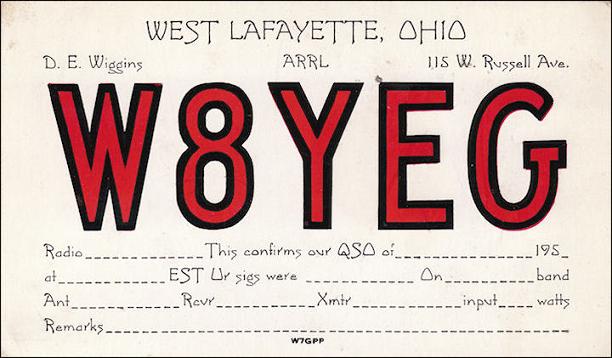
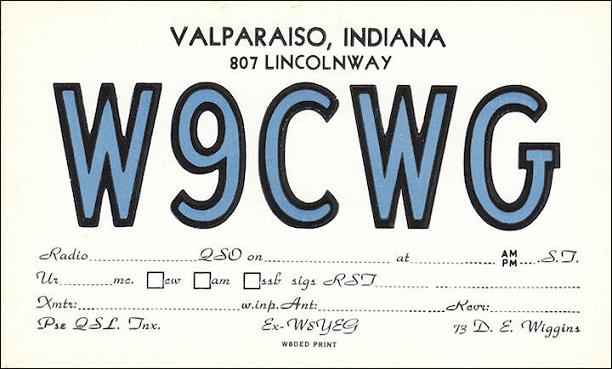
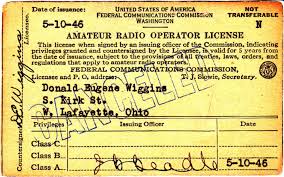
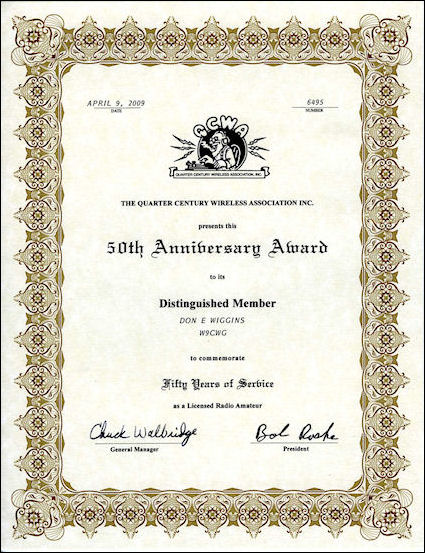
October 1, 2009